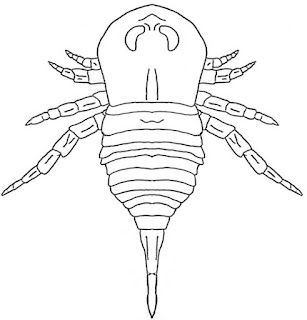I was recently surprised to read a paper about an interesting fossil found near SUNY Ulster, where I teach. It's a place in Kingston that I've been to before and where I've brought students. The fossil was actually discovered over 100 years ago in 1919 and first described in 1932. The slab containing the fossil was apparently collected at that time and now resides in the paleontology collection at Columbia University. The paper I read was a recent reexamination of the fossil (Braddy, S.J. & Gass, K.C. 2023. A eurypterid trackway from the Middle Ordovician of New York State. Journal of Paleontology 97(1): 158-166).
The fossil, as the paper title states, is a eurypterid trackway. Eurypterids are a type of marine arthropod, commonly called sea scorpions, related to modern horseshoe crabs. They existed from the Ordovician Period of geologic time (~465 million years ago) up until the end of the Permian Period (~250 million years ago). Some 250 species of eurypterids have been described ranging in size from 2 cm up to 2.5 m (over 8 feet!) in length. Eurypterids seem to have lived in areas of shallow brackish and/or fresh water.
In 1984, Eurypterus remipes (right) was named the official New York State fossil. There are a couple of important localities for eurypterid fossils in the State, called pools, one near Buffalo and one near Herkimer (Lang Quarry near Herkimer has produced some of the best eurypterid fossils in the world). These "pools" are interpreted to be tidal flat areas where bodies or molts (eurypterids molted like other arthropods) washed up and became buried and fossilized.
One interesting thing about eurypterids is that there's fossil evidence that they could crawl out onto land like modern horseshoe crabs. Horseshoe crabs famously do this in places like the Delaware estuary in late spring on nights of the full moon to spawn - I went to see them spawning on Slaughter Beach in Delaware in May, 2022 - an amazing sight (picture below).
As mentioned, this fossil is a trackway, not an actual fossil of a eurypterid. Paleontologists call these ichnofossils or trace fossils as they represent traces of the organism's activity (another example will be discussed in an upcoming post on Zoophycos).
Identifying what species of animal made a trackway may be difficult of even impossible so trackways are sometimes given their own species names (called ichnospecies). Back in 1932, this particular trackway was assigned the ichnospecies Protichnites gallowayi based on the appearance of the tracks (shown below). The tracks were on a slab of rock which also showed molds of mudcracks indicating the animal was walking across a muddy exposed tidal flat.
Eurypterid trackway from Braddy & Gass (2023). Scale bare 5 cm on top, 1 cm on bottom
With the modern reexamination of this trackway, Braddy & Gass (2023) renamed the ichnospecies to Palmichium gallowayi and believe the tracks appear to have been made by a eurypterid, quite possibly Brachyopterus stubblefieldi, a small (8 cm) eurypterid from the Middle Ordovician Period and known from fossils in Wales (a bit closer to us during the Ordovician). This makes this trackway one of the oldest examples of a eurypterid trackway in the world. A drawing of this eurypterid is shown below.
So, where was this trackway found? There's a park in Kingston called Hasbrouck Park. In older times, the hill, rising from the area along the Rondout Creek, was called the Vlightberg. Along the south side of this park are some steep cliffs which is where surface and underground cement mining was taking place over 100 years ago. It was Rosendale Natural Cement which I've written (and spoken) about numerous times. One small quarry area on the side of the cliffs was called Hill Quarry. The trackway was found on the south side of the entrance to the quarry in the Martinsburg Formation - a highly deformed shale and sandstone sequence from the Ordovician Period just below the famous Taconic unconformity with the overlying carbonate cement rocks.
Back in the Ordovician, a bit over 450 million years, ago, a eurypterid crawled up on a muddy tidal flat. What were they doing? Maybe molting. Maybe massing with other eurypterids to mate like the modern horseshoe crabs. Maybe just strolling in the moonlight - under a Moon that was closer to the Earth back then and forming more extensive tidal mud flats with more extreme tidal variations. The water lapping on the edge of the tidal flat would be warm - at the time we were in the Southern Hemisphere but much closer to the equator than we are today. After the eurypterid went about his business, the trackway baked in the sun the next day and the mud cracked. Then, in the next high tide, sand washed over the trackway and mudcracks and preserved them.
That sediment eventually became buried and lithified into sandstone. Then a mountain building event which formed the massive Taconic Mountains folded those sandstones deep underground. They eventually reached the surface again after tens of millions of years of erosion and were covered by a shallow sea which deposited a thick sequence of sediments (the cement rocks and overlying limestones).
We are very fortunate that humble little trackway made one evening hundreds of millions of years ago made it's way down to the present day for us to wonder about!







No comments:
Post a Comment